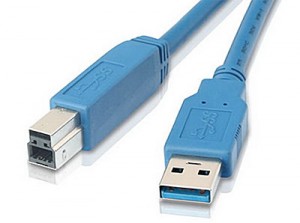
Boasting 10 times the speed of the USB 2.0 ports that have become the standard in connectivity, USB 3.0 ports and cabling should begin to make their way onto the market sometime in early 2010.
Offering transfer rates of up to 4.8Gbit/second compared to the USB 2.0’s rate of 480MBit/second, the 3.0 standard will eventually revolutionize the transfer of large files, such as video, raw digital photos and music mixes.
But don’t worry too much if you’re still using USB 2.0 or even first generation USB 1.1 ports and connections. The new standard is fully backwards compatible. You won’t get the blazing speeds, but you can still use the new cords and connectors in the old ports. They will just transfer at the slower speeds of these older standards.
According to Intel, one of the companies leading the effort to bring USB 3.0 to market, the new ports and cabling will be optimized for low power consumption and improved efficiency. The actual ports and cables will be designed with both copper and optical capabilities. This could mean even faster speeds in the future.
Says Jeff Ravencraft, Intel’s technology strategist, “The digital era requires high-speed performance and reliable connectivity to move the enormous amounts of digital content now present in everyday life. USB 3.0 will meet this challenge while maintaining USB 2.0’s ease-of-use experience.”
The new USB 3.0 ports should begin to appear in late 2009 or more likely early 2010. It’s anticipated that the new technology will be quickly added to computers at a premium price, since manufacturers will be anxious to differentiate themselves from their competitors.
USB 3.0’s arrival wasn’t without problems. Both AMD and NVIDIA challenged Intel, claiming the company was withholding the new standard’s draft certification. This could put Intel at an advantage in the market, since USB 3.0 supports a more flexible power scheme. Even with the new scheme, the sockets still are limited to providing just 500mA of power, which is the same as USB 2.0.
Whether USB 3.0 catches on remains to be seen. Even though FireWire 800 ports have been around for quite a while, its less capable sibling, FireWire 400, is still the standard. Outside of MacPros from Apple, it’s hard to find FireWire 800 support in the marketplace. Consumers just aren’t demanding it. Whether they will want USB 3.0 remains to be seen.
As soon as devices and cabling support for USB 3.0 arrive on the market, you can expect the makers of promotional USB flash drives to quickly get on board. Since the drives are backward compatible, it will be easy for manufacturers to make the switch, knowing that their customers can easily upgrade without fears of incompatibility. Look for USB 3.0 flash drives to arrive in the first half of 2010.
